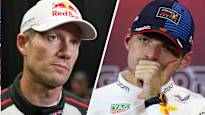Sébastien Ogier and Max Verstappen broke the same rules of conduct. There are many inconsistencies behind the punishments of mega stars, writes Roope Visuri of Urheilu.
Roope Visuriruheluth reporter
In recent weeks, a surprising topic has been stirring up in motorsport: drivers’ conduct penalties. At worst, the recent policies are ruining Formula Ones and rallying, which are dear to Finns.
For Red Bull, which has dominated the F1 series in recent years For Max Verstappen was given “community service” as a punishment when he cursed while barking at his car, which was weaker than the competitors.
For the eight-time rally world champion For Sébastien Ogier a fine of 30,000 euros was imposed for criticizing the jury in the World Rally Championship in Greece. Ogier rejected the too short starting intervals in the opening special stage of the race, as it raised dust dangerously and reduced the visibility of the drivers who started from behind.
The debate has continued after both incidents. Verstappen threatened fresh last weekend with an early termination if he is not allowed to be himself. Other F1 drivers settled down to support the Dutch star.
Ogier on the other hand opened up about his penalty before this week’s World Rally Championship in Chile in the French magazine Autohebdo. According to the multimaster, the reason behind his opening was a concern for safety, although he did not underline it in his violent outburst. Ogier found it sad that drivers are being tried to be silenced.
Ogier’s and Verstappen’s punishments are based on the same articles of the International Automobile Federation’s FIA regulations for inappropriate behavior.
The inconsistency of Verstappen’s punishment is most underlined by the F1 series’ own actions. The F1 series shared Verstappen’s disapproved and punished comment on their own social media accounts.
There was certainly an understanding in the background that such openings are interesting and attract attention. At the same time, however, comments were spread completely against the values of the sentencing decision for children and young people.
The chairman of the FIA is considered to be behind the tightened line Mohammed Ben Sulayemiaalthough the competition juries are responsible for the penalty decisions of the competition weekends.
FIA boss took a stand before the race weekend in Singaporehow cursing should be reduced in team radio discussions allowed to be broadcast on TV and referred to how motor athletes are not “rappers”. He was afraid that children would get bad effects from swearing.
It is special where to draw the line between what is allowed and what is forbidden. At the same time, when swearing is punished and its effects are used to frighten children, for example, children see advertisements for alcohol and gambling companies on F1 tracks and in cars. How do you measure these vices against each other?
Openness increases popularity
Another inconsistency is the events corresponding to the Ogier and Verstappen cases. Like Verstappen at the Singapore GP press conferences were swearing Carlos Sainz and Kevin Magnussenbut they were not penalized.
On the rally side Ott Tänak opened up In Latvia, the jury was harsher than Ogier in Greece. In an interview after the special exam, he roared with profanity how the jury only pulls a good dinner with wine.
Tänak was not punished for this. Ogier also seemed to be right in his criticism, because in Greece immediately after the opening special test, the starting intervals were extended.
Of course, complete excesses must be addressed. For example, a Japanese F1 driver Yuki Tsunoda received a fine of 40,000 euros (20,000 euros suspended) during the race weekend in Austria in June, when he called his competitors lagging behind. Such speeches should not be allowed.
Ogier and Verstappen’s penalties have still been overreacted.
The new flourishing of Formula 1 is based precisely on the fact that a previously very closed culture has been opened up. The most well-known example is, of course, the Netflix documentary series that had a huge impact on the sport’s popularity.
Smaller examples of F1 figures being miked and cameras being allowed deeper into the pits can be found in the darkest of social media. Openness should be a virtue.
There are now many question marks surrounding the future of the World Rally Championship as well. Censoring star driver doesn’t help with that.
This kind of activity is worrying. If the gags return and the popularity of car racing decreases, the sport bosses can only blame themselves.
